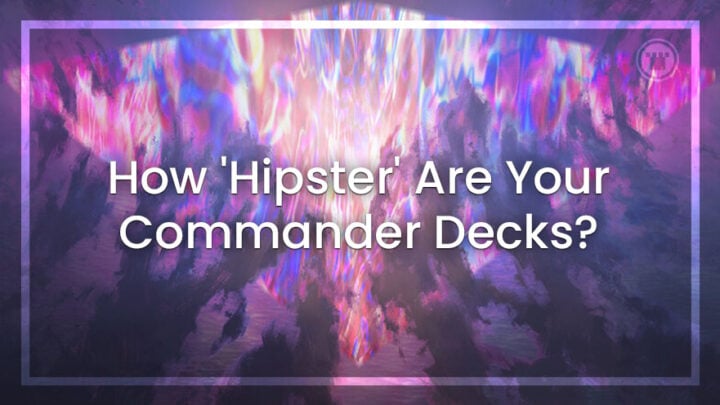Recently, I got tagged in a post on Twitter. Magic Data Science developed a tool over at EDHRec that allows players to see the “Hipster Quotient” of their Commander decks. Hipster Quotient is defined as “the sum of the proportion of all recorded EDH decks in which its constituent cards (excluding basic lands) appear.” In other words, how original is your deck?
It’s a neat idea, and in the article MtGDS wrote about it on EDHRec they propose using the Hipster Quotient as the basis for a new way to play EDH. The idea here is to combat the proliferation of “auto-includes,” as it can be easy to fall into building lists where the first 20, 30, even 40 or more cards are essentially predetermined.
Here’s how the calculator works. If you want a fully, cogent explanation, I highly recommend looking at the article on EDHRec that I mentioned near the beginning of this article. The short version is that you find the percentage of decks on EDHRec that a given card in your deck (excluding basic lands) appears in, do that for every card in your deck and add all those percentage together.
So, the most that any one card could add to the deck is 100%, although there is no card that can manage that. The most used cards in Commander right now are probably Sol Ring, Command Tower and Arcane Signet, which have usage rates of 83.7%, 71.6 % and 64.7%, respectively. This means any deck that’s running all three of those starts with a baseline Hipster Quotient of 220%.
Putting Myself Through the Calculator
I know running staple packages is a trap I tend to fall into, a hypothesis immediately proven correct once I ran some of the decks I’ve built over the last couple of years through the Hipster Dragon Highlander Calculator. MtGDS used a game I played in for Commander Kingdom as an example in their tweet. While my Slimefoot, the Stowaway deck had a surprisingly hipstery choice of a Commander, the rest of the deck was relatively mainstream.

Black-Green token-y decks are going to be at a bit of a disadvantage when it comes to avoiding a high quotient, as a lot of early ramp spells and token engine cards (think things like Cultivate/Kodama’s Reach and Skullclamp/Ashnod’s Altar) score a lot of percentage points, and this deck ran a lot of those kinds of cards.
To be fair, the bottom end of the deck is a bunch of Thallids and saprolings, so my thinking at the time was to go down a little more powerful and proven path with the support cards if the creatures would be largely underwhelming if the synergies didn’t hit.
But that wasn’t the least hip deck I put together for Commander Kingdom. That would be this Garth, One-Eye list that had a Maze’s End subtheme:

The five-color mana base, ramp and mana rocks really drove up the quotient here. Running the full guildgate suite also bumps things up a notch, as while no one guildgate is worth that many percentage points, added together they do some damage.
Beyond all that, though, I fully admit this is about as close to a pure “good stuff” deck as I’ll ever build. I mostly just wanted to start bouncing Garth and playing as many Black Lotuses as possible. Ironically, it was the guildgates and the rest of my mana base that killed me in that game on stream. Not because I didn’t get the right colors or anything, but because my opponents saw a guildgate and The World Tree and got scared I was going to go ham with gods (didn’t even occur to me to try and build that) and stomped me out of the game. Oops!

My favorite deck I ever played on Commander Kingdom was this nifty little Pramikon deck. Pramikon is a commander that wants to be redeployed a lot, blanking attacks from either side. The easiest way to reliably do this is to build a blink/flicker deck. As a popular archetype, that means all the cards that enable the strategy increases the hipster quotient a good amount.
This deck is a good illustration that a high hipster quotient doesn’t necessarily make for a generic feeling deck. In this case, Pramikon itself has such a game-altering effect that it’ll keep things fresher than the rest of the 99 may seem to indicate.
If you ever watched Commander Kingdom or its companion show, Crowdsource Commander, where I built the decks live on stream (both shows are still available to watch on our YouTube channel), I would often say I had to sometimes curb my normal deckbuilding tendencies for those shows in order to make decks that would be fun to watch on a stream.
That’s a handy excuse, so let’s blow it up: Here’s two Jon Irenicus decks I built for a different article on this blog. The idea here was to build a semi-modular deck that could pivot between power levels and playing styles while keeping a core that didn’t need to be swapped out. So how did those decks do on the Hipster Quotient?


Definitely hipper, although the “more powerful” version was certainly relying on some solid standbys. I guess in the end it’s just nice to know I have range. Also, playing a ton of creatures with pretty massive downsides isn’t exactly the most popular thing on EDHRec… outside of decks exactly like these.
The more powerful version of the deck relies a little less on Jon giving everything away, so it plays a lot more generically powerful cards rather than leaning as hard into the Commander, upping the score a bit.
Hipster Dragon Highlander
All those numbers above are based off a sample size of…well, just me. A sample size of one is a little hard to put into context, even with those handy percentile numbers attached. Here’s some loose guidelines from the app itself:
– 1,500% is basically the most mainstream you could possibly expect to see with a legal deck
– The typical pre-constructed Commander Deck is at about 400%, but they range from 150% to 600%.
– The median deck on EDHREC is at about 463%.
– 50% of decks on EDHREC are between about 347% and 571%; 90% fall between 169% and 719%.
– Anything less than about 150% is legitimately Hipster.
So. what do we do with all of this? Well, MtGDS suggested a format based off the HDHCalculator, and I really like that idea. Like 2DH, where no card in your 99 can cost over $2 and the commander can’t cost more than $5, it’s another way to shake up the way you build a deck.
The question is, where should the Hipster Quotient limit be set for the hypothetical Hipster Dragon HIghlander? I like the idea of using the average Precon rate of 400%. As recent precons have shown, the reputation Precons have as pushover decks is starting to become quite outdated.
But in the end, I think I like the idea of using the Hipster quotient as more of a deckbuilding challenge. Say you have a weekly game. Start one week where decks need to have a hipster quotient of 700% or less. Not too much of a restriction, but enough to keep folks from building purely good-stuff/staple decks.
Every week thereafter, the threshold drops by 50%. In just a few weeks, the decks are going to play wildly different as you realize that simply switching to less popular versions of the same effect might not always work. You’ll have to stretch and really explore everything that a deck with a given commander can do.
End Step
I am very happy that Hipster Dragon Highlander and the HDH Calculator exist. Anything that provides another avenue for creativity and play is welcome. One of the greatest strengths of Magic is it’s not just one game, and the fact that people are still finding interesting and fun new ways to play various formats 30 years in is a testament to the strength of its underlying mechanics.
If Commander ever starts to feel a little stale to you, the games playing out the same with the same cards in a rut, I highly recommend looking into Hipster Quotients and introducing the idea of Hipster Dragon Highlander to your playgroup. Commander is no longer the niche format it once was, so finding a way to still feel hipstery about it scratches a certain itch for someone who’s been playing since before the first Precons.

Chris is the Marketing Communications Coordinator (and editor of the blog) at Card Kingdom. He would like to apologize to his son for not holding onto more cards from when he first started playing, as that likely would have paid for college. He enjoys pretty much all formats of Magic, but usually ends up playing decks that make other people dislike playing those formats with him.

